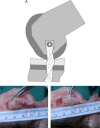Rotational Shortening of Collateral Ligament in TKR With Severe Deformity
- PMID: 30542231
- PMCID: PMC6250263
- DOI: 10.1097/BTO.0000000000000277
Rotational Shortening of Collateral Ligament in TKR With Severe Deformity
Abstract
Instability of the knee joint after total knee replacement (TKR) is one of the most important reasons for revision TKR. Inadequate release or tightening of the collateral ligaments in the knee joint may cause instability and early failure. This study presents a case series study of a new technique for ligament balancing wherein the collateral ligament is detached from its origin and rotated (twisted) around its longitudinal axis to tighten the ligament before the origin is reattached to its original position. The surgical technique for collateral ligament tightening during TKR was performed on 6 patients with a deformed knee caused by osteoarthritis and rheumatoid arthritis. The range of motion, knee society score, and laxity of the patients' knee joint, after 7 months to 13 years of follow-up, were evaluated. The technique was successful, achieving good range of motion and satisfactory stability of the joint. Further evaluation in a larger number of cases and a comparative analysis with different techniques would further support the usefulness of this rotational ligamentoplasty technique.
Keywords: TKR; arthroplasty; rotational ligamentoplasty.
Figures



Similar articles
-
Tightening medial collateral ligament during total knee arthroplasty for patients with fixed valgus deformity: A novel technique.J Orthop Surg (Hong Kong). 2019 Jan-Apr;27(1):2309499019834695. doi: 10.1177/2309499019834695. J Orthop Surg (Hong Kong). 2019. PMID: 30862275
-
Correcting Severe Varus Deformity Using Trial Components During Total Knee Arthroplasty.J Arthroplasty. 2017 May;32(5):1488-1495. doi: 10.1016/j.arth.2016.11.043. Epub 2016 Dec 1. J Arthroplasty. 2017. PMID: 28017574
-
Collateral ligament strains during knee joint laxity evaluation before and after TKA.Clin Biomech (Bristol). 2013 Aug;28(7):777-82. doi: 10.1016/j.clinbiomech.2013.06.006. Epub 2013 Jun 29. Clin Biomech (Bristol). 2013. PMID: 23820027
-
["Ligament balancing" and varus deformity in total knee arthroplasty].Orthopade. 2007 Jul;36(7):643-4, 646-9. doi: 10.1007/s00132-007-1111-6. Orthopade. 2007. PMID: 17593349 Review. German.
-
[Lateral unicompartmental knee arthroplasty - a challenge].Oper Orthop Traumatol. 2017 Feb;29(1):17-30. doi: 10.1007/s00064-016-0476-2. Epub 2016 Dec 12. Oper Orthop Traumatol. 2017. PMID: 27957592 Review. German.
References
-
- Sharkey PF, Hozack WJ, Rothman RH, et al. Why are total knee arthroplasties failing today? Clin Orthop Relat Res. 2002;404:7–13. - PubMed
-
- Krackow KA. Revision total knee replacement ligament balancing for deformity. Clin Orthop Relat Res. 2002;404:152–157. - PubMed
-
- Beverland D. Ligament balancing in tka: avoiding tissue releases. Bone Joint J Orthop Proc Suppl. 2015;97:127–127.
-
- Mulhall KJ, Ghomrawi HM, Scully S, et al. Current etiologies and modes of failure in total knee arthroplasty revision. Clin Orthop Relat Res. 2006;446:45–50. - PubMed
LinkOut - more resources
Full Text Sources
